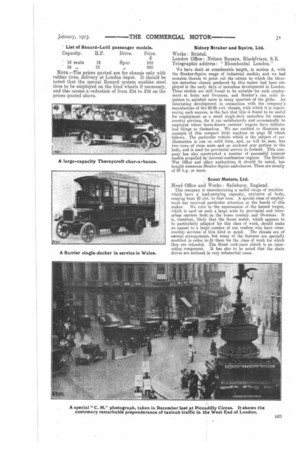Sidney Straker and Squire, Ltd.
Page 53

Page 54

If you've noticed an error in this article please click here to report it so we can fix it.
Works : Bristol.
London Office : Nelson Square, Blackfriars, S.E. Telegraphic address : " Rhomboidal London," We have dealt at considerable length, in section A, with the Straker-Squire range of industrial models, and we had occasion therein to point out the extent to which the threeton motorbus chassis produced by this maker had been employed in the early days of motorbus development in London. These models are still found to be suitable for such employment at, home and Overseas, and Straker's can refer inquirers to satisfied users in many quaiters of the globe. An interesting development in connection with the company's manufacture of the 20.25 cwt. chassis, with -which it is experiencing such success, is the fact, that this is found to be useful for employment as a small single-deck motorbus for remote country services, for it can. satisfactorily and economically be employed, where horse-drawn carriers' wagons have hitherto had things to theinselves. We are enabled to illustrate an example of this compact little machine on page 32 which follows. The particular vehicle which is the subject of our illustration is run • on solid tires, and, as will be seen, has two rows of cross seats and an enclosed rear portion to the body, and is used for provincial service in Ireland. This company has also, constructed a number of successful tramcar models propelled by internal-combustion engines. The British War Office and other authorities, it should be noted, has bought numerous Straker-Squire ambulances. These are usually of 24 h.p. or more.
Scout Motors, Ltd.
Head Office and Works : Salisbury, Engla,nd.
This company is manufacturing a useful range of machine which have a loadcarrying capacity, exclusive of body, ranging from 10 cwt. to four tons. A special class of employment has received particular attention at the hands of this maker. We refer to the supersession of the horsed wagon, which is used onsuch a large scale by provincial and interurban carriers hothAn the home country and Overseas. It is, therefore, likely that the Scout motor, which appears to bo particularly adapted for this class of work, should make an appeal to a large: number of our readers, who have crosscountry services of this kind in mind. The chassis are of nermel arrangement; but many of the features are specially modified in order to.fit them for the class of work for which they are intended. The Scout cork-inset clutch is an interesting component. It has also to be noted that the chain drives are enclosed in very substantial cases.
John I. Thornycroft and Co., Ltd.
Works: Southampton and Basingstoke. London Office : Caxton House, Westminster, S.W. Telegraphic address : "Thornycroft London."
The standard types of chassis made by John I. Thornycroft and Co., Ltd., are listed in the course of the n6tiee of that company's machines in Section A, which deals with goods transport. Many of these chassis are suitable for passengervehicle work, notably the 16 h.p., two-cylinder chassis, 30 h.p., four-cylinder chassis, and the new 30 h.p. four-cylinder 75-cwt. model. Thornycroft machines have been employed extensively in the past for passengersearrying work in many native districts. The simplicity of the chassis design and its general sturdiness of construction seem to render Thornycroft machines particularly useful in this field of employment. As an example, we may recall, to mind the unique service which has been performed by Thornycroft vehicles in Southern Nigeria. There, under very severe. conditions, Thornycsoft passenger and goods-transport vehicles have created a name for themselves which it would be difficult to surpass.
We illustrate a modern type of Thornycroft char-a-banes on the previous page. This class of machine is securing considerable approval front users in British provincial and seaside resorts.
We may perhaps again mention in this section the special War Office subsidy type of machine which has been introduced by Thornvcroft's. This is known as typa K, and is a powerful model., capable of carrying gross loads up to 4 tons, including the weight of the body, which is specially constructed to withstand bad Colonial roads, and is worthy of particular attention. Two specially-narrow chassis, types B and 1). of which the overall width is 5 ft. 6 in., are particularly suitable for use over narrow reads.
W. A. Stevens, Ltd. VV'orks: Maidstone.
Chief Office: 26, Victoria Street, S.W. Telegraphic address : " Petelobus London."
No review of the work of manufacturers of modern passenger-transport vehicles would be complete in this present issue, without some mention of the special type of machine which is produced by W. A. Stevens, Ltd. ; these are of the petrol-electric class. At present the Maidstone works are kept so very busy in regard to the production of chassis for London omnibus employment, that other branches of roadhanlage work have had little attention at the company's hands. The present system has been evolved after severe use. The Tilling-Stevens petrol-electric omnibus has, in spite of much antipathy which has been; shown towards this class of construction in the past, now achieved remarkable .success in London traffic. Thomas Tilling, Ltd., the well-known London omnibus proprietor, now Owns a fleet of 82 petrolelectric omnibuses of this make; 200 more are on order.
A four-cylinder petrol engine drives, by means of a spring coupling, a motor-generator ; power is then taken by means of a long propeller shaft to a worm.drive live back axle. For quietness of running, efficiency of acceleration and deceleration, and particularly for the comfort of the passengers, the Tilling-Stevens has proved itself hard to beat. Its employment is likely to increase rapidly for such work.


























































































